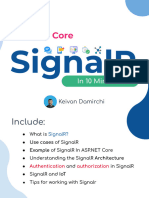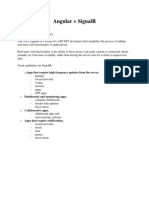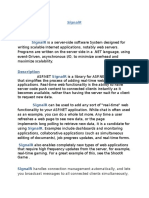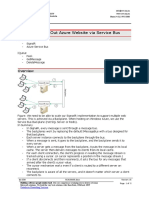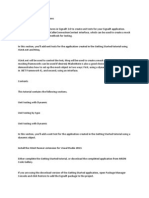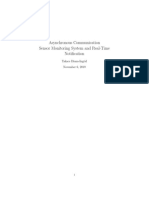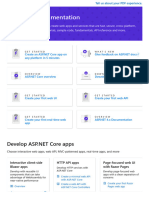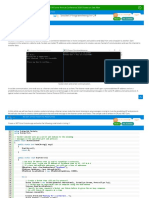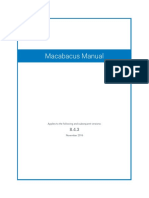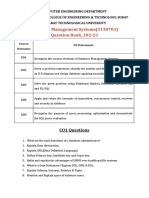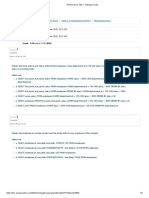28/2/2020 Simple SignalR Server and Client Applications Demonstrating Common Usage Scenarios - CodeProject
Simple SignalR Server and Client Applications
Demonstrating Common Usage Scenarios
Mustafa Kok
16 Jul 2019 CPOL
SignalR server and client applications for demonstrating common scenarios like connecting, disconnecting, joining and leaving
groups, sending messages to all clients, to specific or group of clients
Source code for the sample applications (GitHub)
Introduction
SignalR is a library that simplifies the real-time communication between the web page and the server. It uses WebSockets or long-
polling method depending on the web browser used.
There are too many articles about hosting a SignalR hub and communicating with it from a client applications. But some of them are
too simple (just show how to send a message), some of them are too complex that are hard to understand and some of them have
badly organized code. I wanted to demonstrate simple scenarios with simple code samples with almost no extra code.
Demonstrated scenarios are:
Self hosting a SignalR server with a sample hub on a WindowsForms application
Connecting to SignalR hub from WindowsForms and JavaScript clients
Subscribing to hub events (callback methods) from client applications
Calling methods defined on a hub, from client applications
Joining and leaving groups from client applications
Broadcasting messages to all clients, to group of clients or to a single client from a SignalR hub
WinForms Server Application
WindowsForms self hosted SignalR application looks like this.
https://www.codeproject.com/Articles/5162436/Simple-SignalR-Server-and-Client-Applications-Demo?display=Print 1/8
�28/2/2020 Simple SignalR Server and Client Applications Demonstrating Common Usage Scenarios - CodeProject
To host a SignalR server on a WindowsForms application, the following nuget packages must be installed either from Package
Manager Console or from Manage Nuget Packages window.
Microsoft.Owin.SelfHost
Microsoft.Owin.Cors
Microsoft.AspNet.SignalR.Core
Microsoft.AspNet.SignalR.SelfHost
The next step is preparing the self-hosting environment. To do this, create a class named Startup and add the following code
into it. The Configuration method will be called automatically by the self hosting environment.
class Startup
{
public void Configuration(IAppBuilder app)
{
//CORS need to be enabled for calling SignalR service
//from external web applications/pages
app.UseCors(CorsOptions.AllowAll);
//Find and register SignalR hubs
app.MapSignalR();
}
}
To start Web Application which hosts the SignalR service, call WebApp.Start method with the desired SignalR service address.
_signalR = WebApp.Start<Startup>(txtUrl.Text);
The next step is preparing the SignalR hub class which will handle the communication with the clients. Every SignalR hub class
derives from Microsoft.AspNet.SignalR.Hub class. It includes methods that can be called by the clients. It can also raise
https://www.codeproject.com/Articles/5162436/Simple-SignalR-Server-and-Client-Applications-Demo?display=Print 2/8
�28/2/2020 Simple SignalR Server and Client Applications Demonstrating Common Usage Scenarios - CodeProject
events (call callback methods on clients) that clients can listen to.
public class SimpleHub : Hub
{
//Called when a client is connected
override OnConnected()
//Called when a client is disconnected
override OnDisconnected(bool stopCalled)
//Public methods inside this region are callable from any SignalR client
#region Client Methods
//A client provides a user name for himself
void SetUserName(string userName)
//Client calls this to join a group
Task JoinGroup(string groupName)
//Client calls this to leave a group
Task LeaveGroup(string groupName)
//Clients call this to send a message to the hub
//Hub then broadcasts the message to all the connected clients
void Send(string msg)
#endregion
}
Context property of a hub whose type is HubCallerContext has several properties that provide information about current
request like ConnectionId, Headers and RequestCookies.
Clients property can be used to perform operations on all the connected clients or on specific clients. Every client has a
ConnectionId which can be used for performing operations on a client. The following calls return dynamic objects which can
be used to invoke operations on the client side.
//For all the clients
Clients.All
//For a specific client
Clients.Client(connectionId)
//For clients that are members of a group
Clients.Group(groupName)
The following code block invokes addMessage operation on all the clients. If no such operation is defined on the client side,
nothing happens.
Clients.All.addMessage(senderUserName, message);
Groups property can be used to add or remove clients to groups.
//To add a user to a group
Groups.Add(userConectionId, groupName);
//To remove a user from a group
Groups.Remove(userConectionId, groupName);
A new instance of the hub class is created for each request, so hub classes cannot contain any state. Also, it is not possible to
add instance events to a hub class and track the operations by subscribing to these events.
To overcome this problem, two methods can be used:
1. Adding static state variables and events
2. Injecting a state object to each created hub instance, using dependency injection
https://www.codeproject.com/Articles/5162436/Simple-SignalR-Server-and-Client-Applications-Demo?display=Print 3/8
�28/2/2020 Simple SignalR Server and Client Applications Demonstrating Common Usage Scenarios - CodeProject
In this sample project, I have used static variables and events approach for simplicity. So the SimpleHub class contains a static
dictionary for holding state data for connected clients and several static events to inform its subscribers.
static ConcurrentDictionary<string, string> _users = new ConcurrentDictionary<string, string>
();
public static event ClientConnectionEventHandler ClientConnected;
public static event ClientConnectionEventHandler ClientDisconnected;
//...
In order to send a message from server to clients (or invoke an operation on a client), we need to access the Clients property of
the hub, but it is normally only available when processing a request in a hub method. There is, of course, another way to access hub
related context outside a hub class. Microsoft.AspNet.SignalR.GlobalHost has several static properties that can be
used to access and manipulate SignalR host. One of them is ConnectionManager property.
The following code gets the hub context for SimpleHub type and invokes a method on all the connected clients.
var hubContext = GlobalHost.ConnectionManager.GetHubContext<SimpleHub>();
hubContext.Clients.All.addMessage("SERVER", txtMessage.Text);
WinForms Client Application
WindowsForms client application looks like this:
For SignalR client components, add Microsoft.AspNet.SignalR.Client nuget package to the project.
The first step of connecting to a SignalR hub is creating a HubConnection to the SignalR server. Then, getting the proxy object
that will be used to communicate with the desired hub.
//Create a connection for the SignalR server
_signalRConnection = new HubConnection(txtUrl.Text);
https://www.codeproject.com/Articles/5162436/Simple-SignalR-Server-and-Client-Applications-Demo?display=Print 4/8
�28/2/2020 Simple SignalR Server and Client Applications Demonstrating Common Usage Scenarios - CodeProject
//Get a proxy object that will be used to interact with the specific hub on the server
//There may be many hubs hosted on the server, so provide the type name for the hub
_hubProxy = _signalRConnection.CreateHubProxy("SimpleHub");
The next step is to register hub events (methods invoked by the hub). The following code registers a handler method for
AddMessage event. Registered lambda expression takes two parameters and writes them to log area.
_hubProxy.On<string, string>("AddMessage",
(name, message) => writeToLog($"{name}:{message}"));
After configuring the hub events, it is time to connect to SignalR hub by calling the Start method of the HubConnection
object.
await _signalRConnection.Start();
Public operations defined on the connected hub can be invoked using the IHubProxy objects Invoke method with the
remote operation's name and required parameters. Sample code invokes the Send method of SimpleHub class.
_hubProxy.Invoke("Send", txtMessage.Text);
JavaScript Client Application
JavaScript client application looks like the WinForms client application. I tried to construct a similar interface and implement exactly
the same operations. The only functional difference is, user interface elements are enabled and disabled based on the current state.
https://www.codeproject.com/Articles/5162436/Simple-SignalR-Server-and-Client-Applications-Demo?display=Print 5/8
�28/2/2020 Simple SignalR Server and Client Applications Demonstrating Common Usage Scenarios - CodeProject
JavaScript client uses jQuery and jQuery.signalR script libraries. You can add them to your project by installing the
following nuget packages:
jQuery
Microsoft.AspNet.SignalR.JS
In order to connect and use remote SignalR hub, another script library must be referenced. But it is not a file that you can locate and
add as a script reference in HTML file. This script is automatically generated by the SignalR server. Script address is "signalR
address" + "/hubs"
<script src="http://localhost:8080/signalr/hubs"></script>
<!-- or relative path -->
<script src="~/signalr/hubs"></script>
The test client application can connect any signalR service by entering the URL address of the service into the Url inputbox. So the
script location is not to be fixed for this sample application. In order to solve dynamic script location problem, I have loaded this
automatically created hubs script inside the connect function using the jQuery.getScript function. getScript function
takes two parameters; address of the JavaScript to be loaded and a function that will be called when downloading the script has
finished. As you can see in connect JavaScript function in the sample Index.html page, actual connection operations are
performed after this auto generated has downloaded successfully.
https://www.codeproject.com/Articles/5162436/Simple-SignalR-Server-and-Client-Applications-Demo?display=Print 6/8
�28/2/2020 Simple SignalR Server and Client Applications Demonstrating Common Usage Scenarios - CodeProject
//Connect to the SignalR server and get the proxy for simpleHub
function connect() {
//Load auto generated hub script dynamically and perform connection
//operation when loading completed
//SignalR server location is specified by 'Url' input element,
//hub script must be loaded from the same location
//For production, remove this call and uncomment the script block in the header part
$.getScript( $("#txtUrl").val() + "/hubs", function() {
$.connection.hub.url = $("#txtUrl").val();
// Declare a proxy to reference the hub.
simpleHubProxy = $.connection.simpleHub;
//Register to the "AddMessage" callback method of the hub
//This method is invoked by the hub
simpleHubProxy.client.addMessage = function (name, message) {
writeToLog(name + ":" + message);
};
//Connect to hub
$.connection.hub.start().done( function () {
writeToLog("Connected.");
simpleHubProxy.server.setUserName($('#txtUserName').val());
});
});
}
Steps for connecting and interacting with a SignalR hub are the same as WindowsForms client. Sample code demonstrates how to
prepare a connection to a SignalR hub, create a proxy for interacting with it, registering a server event (or callback) and calling
(invoking) a method (setUserName in this case) on the server side.
There is a simple JavaScript function for each operation. For example, following is the sendMessage function that send the
provided message to the server by invoking the "send" method with the text entered into txtMessage input box.
//Send a message to server
function sendMessage() {
if(simpleHubProxy != null) {
simpleHubProxy.server.send($('#txtMessage').val());
}
}
History
16th July, 2019: Initial version
License
This article, along with any associated source code and files, is licensed under The Code Project Open License (CPOL)
About the Author
https://www.codeproject.com/Articles/5162436/Simple-SignalR-Server-and-Client-Applications-Demo?display=Print 7/8
�28/2/2020 Simple SignalR Server and Client Applications Demonstrating Common Usage Scenarios - CodeProject
Mustafa Kok
Software Developer (Senior) Freelance
Sweden
Experienced senior C# developer, sometimes codes in Java and C++ also. He designs and codes desktop applications (WinForms,
WPF), windows services and Web APIs (WCF, ASP.Net MVC). He is currently improving his ASP.Net MVC and JavaScript
capabilities. He acts as an architect, coder and trainer.
He is mostly experienced in Media Asset Management (MAM) applications, broadcasting sector and medical applications.
LinkedIn: www.linkedin.com/in/mustafa-kok-75352944/
GitHub: github.com/nthdeveloper
StackOverflow: stackoverflow.com/users/1844220/nthdeveloper
Comments and Discussions
6 messages have been posted for this article Visit https://www.codeproject.com/Articles/5162436/Simple-SignalR-Server-
and-Client-Applications-Demo to post and view comments on this article, or click here to get a print view with messages.
Permalink Article Copyright 2019 by Mustafa Kok
Advertise Everything else Copyright © CodeProject, 1999-
Privacy 2020
Cookies
Terms of Use Web05 2.8.200227.1
https://www.codeproject.com/Articles/5162436/Simple-SignalR-Server-and-Client-Applications-Demo?display=Print 8/8



